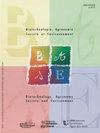A farm survey on the presence of dioxins and dl-PCB in beef production systems in Switzerland
IF 0.6
4区 农林科学
Q3 AGRONOMY
Biotechnologie Agronomie Societe et Environnement
Pub Date : 2018-02-10
DOI:10.4013/BASE.2018.151.03
引用次数: 2
Abstract
In 2006, new maximum levels for the concentration of dioxins (PCDD/F) and dioxin-like PCB (dl-PCB) in food entered into force in the European Union [Regulation (EC) No 199/2006]. The Swiss Confederation decided to adopt these values from the 1 January 2009 on (RS 817.021.23). A previous appraisal showed that beef from extensive production systems in Switzerland may exceed the new maximum level of 4.5 pg WHO97-TEQ·g-1 fat. In order to identify the reasons of the presence of dioxins (PCDD/F) and dioxin-like PCB in Swiss beef, a detailed survey was conducted on eight farms in 2008. Depending on the production system, on each farm several suckler cows and their calves or fattening bulls and heifers were selected and followed over several months. Samples of soil, milk, forages, concentrates and meat were taken and analyzed according to standard protocols. The sum of PCDD/F and dl-PCBs in soil averaged 1.4 pg WHO97-TEQ·g-1 dry matter (DM) across all farms. The mean value found in feed samples was 0.25 pg WHO97-TEQ·g-1 feed (88% DM), which is considerably lower than the legal maximum level of 1.25 pg WHO97-TEQ·g-1 feed. The mean value of milk from suckler cows was 2.75 pg, and the one of milk from dairy cows was 2 pg WHO97-TEQ·g-1 fat. Although two individual beef samples (out of 36) slightly exceeded the legal limit of 4.5 pg WHO97-TEQ·g-1 fat, the mean value of all beef samples was 2.3 pg WHO97-TEQ·g-1 fat. The results did not allow to establish direct relationships between the presence of contaminants in feeds and milk or beef and they showed that variation in PCDD/F and dl-PCB contamination of meat within the same farm was very high. It can be concluded that the situation in Switzerland seems not to be alarming and that no particular measures have to be taken. Nevertheless farmers should be aware that extensive production coupled with absence of delay between weaning and slaughtering may induce some risk for producing non compliant beef.一项关于瑞士牛肉生产系统中二恶英和多氯联苯存在的农场调查
2006年,欧盟食品中二恶英(PCDD/F)和二恶英样多氯联苯(dl-PCB)新的最高浓度标准在欧盟生效[法规(EC) No 199/2006]。瑞士联邦决定从2009年1月1日起(RS 817.021.23)采用这些值。先前的一项评估表明,瑞士广泛生产系统的牛肉可能超过4.5 pg WHO97-TEQ·g-1脂肪的新最高水平。为了查明瑞士牛肉中含有二恶英(PCDD/F)和类二恶英多氯联苯的原因,2008年对8个农场进行了详细调查。根据生产系统的不同,每个农场都会挑选几头乳牛和它们的小牛,或肥壮的公牛和小母牛,对它们进行几个月的跟踪。采集土壤、牛奶、牧草、浓缩物和肉类样品,并根据标准规程进行分析。各农场土壤PCDD/F和dl-PCBs的干物质(DM)平均值为1.4 pg WHO97-TEQ·g-1。饲料样品中发现的平均值为0.25 pg WHO97-TEQ·g-1饲料(88% DM),远低于法定最高水平1.25 pg WHO97-TEQ·g-1饲料。乳牛产乳的平均值为2.75 pg,奶牛产乳的平均值为2 pg WHO97-TEQ·g-1脂肪。虽然36份牛肉样本中有两份略高于法定限值4.5 pg WHO97-TEQ·g-1,但所有牛肉样本的平均值为2.3 pg WHO97-TEQ·g-1。研究结果不能确定饲料和牛奶或牛肉中存在的污染物之间存在直接关系,而且研究结果表明,同一农场内肉类中PCDD/F和dl-PCB污染的差异非常大。可以得出的结论是,瑞士的局势似乎并不令人震惊,不需要采取特别措施。然而,农民应该意识到,大规模生产加上断奶和屠宰之间没有延迟,可能会导致生产不合规牛肉的一些风险。
本文章由计算机程序翻译,如有差异,请以英文原文为准。
求助全文
约1分钟内获得全文
求助全文
来源期刊

Biotechnologie Agronomie Societe et Environnement
AGRONOMY-ENVIRONMENTAL SCIENCES
CiteScore
1.60
自引率
0.00%
发文量
12
审稿时长
6-12 weeks
期刊介绍:
BASE publishes original papers in the fields of life sciences: environmental science and technology, forest and natural space management, agronomical science, and chemistry and bio-industries.
 求助内容:
求助内容: 应助结果提醒方式:
应助结果提醒方式:


